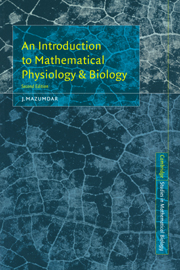Book contents
- Frontmatter
- Contents
- PREFACE TO THE SECOND EDITION
- PREFACE TO THE FIRST EDITION
- Chapter 1 DIMENSIONAL ANALYSIS IN MATHEMATICAL PHYSIOLOGY
- Chapter 2 THE MATHEMATICS OF DIFFUSION
- Chapter 3 POPULATION BIOLOGY
- Chapter 4 BIOGEOGRAPHY: MATHEMATICAL ANALYSIS OF WILDLIFE RESERVES
- Chapter 5 PHARMACOKINETICS: DRUG DISTRIBUTION IN PHARMACOLOGY
- Chapter 6 MATHEMATICAL MODELLING IN EPIDEMIOLOGY
- Chapter 7 MODELLING THE AIDS EPIDEMIC
- Chapter 8 BIOLOGICAL FLUID MECHANICS
- Chapter 9 ANALYSIS AND APPLICATIONS OF LEFT VENTRICULAR MECHANICS
- Chapter 10 ANALYSIS AND APPLICATIONS OF HEART VALVE VIBRATION
- Chapter 11 MEDICAL DEVICES
- GLOSSARY OF TERMS
- REFERENCES
- INDEX
Chapter 9 - ANALYSIS AND APPLICATIONS OF LEFT VENTRICULAR MECHANICS
Published online by Cambridge University Press: 05 June 2012
- Frontmatter
- Contents
- PREFACE TO THE SECOND EDITION
- PREFACE TO THE FIRST EDITION
- Chapter 1 DIMENSIONAL ANALYSIS IN MATHEMATICAL PHYSIOLOGY
- Chapter 2 THE MATHEMATICS OF DIFFUSION
- Chapter 3 POPULATION BIOLOGY
- Chapter 4 BIOGEOGRAPHY: MATHEMATICAL ANALYSIS OF WILDLIFE RESERVES
- Chapter 5 PHARMACOKINETICS: DRUG DISTRIBUTION IN PHARMACOLOGY
- Chapter 6 MATHEMATICAL MODELLING IN EPIDEMIOLOGY
- Chapter 7 MODELLING THE AIDS EPIDEMIC
- Chapter 8 BIOLOGICAL FLUID MECHANICS
- Chapter 9 ANALYSIS AND APPLICATIONS OF LEFT VENTRICULAR MECHANICS
- Chapter 10 ANALYSIS AND APPLICATIONS OF HEART VALVE VIBRATION
- Chapter 11 MEDICAL DEVICES
- GLOSSARY OF TERMS
- REFERENCES
- INDEX
Summary
Analysis and Interpretation of Left Ventricular Nonlinear Constitutive Properties During Diastole and Systole
With the rapid advance in medical technology, there has been an expansive array of new research tools for the analysis and integration of physiological data. These newer techniques have facilitated physiologists to reappraise the traditional concepts underlying the evaluation and assessment of cardiac performance. For some time, function of the heart was characterized solely in terms of its pumping efficiency. However, in assessing cardiac function an understanding and knowledge of the stress developed within the wall of the left ventricle (LV) during a cardiac cycle is of paramount importance. Some of the material properties of the left ventricle, such as diastolic stiffness, are an important reflection of myocardial disease, for example, cardiomyopathy. However, variation in the regional material constitutive property can help detect the location of myocardial infarct. Left ventricular wall stress is another property which can indicate the degree of left ventricular compensation to pressure and/or volume overload, which occurs with valvular disease. For the determination of both left ventricular stress and stiffness properties, ventricular pressure and geometry data are required. At present this information can only be determined using simultaneous cardiac catheterization and cineangiocardiography for pressure and geometry, respectively.
For the purpose of mathematical analysis, the LV will be modelled as a uniformly thick-walled pressurized spherical shell of homogeneous but nonlinear material properties.
- Type
- Chapter
- Information
- An Introduction to Mathematical Physiology and Biology , pp. 179 - 185Publisher: Cambridge University PressPrint publication year: 1999



